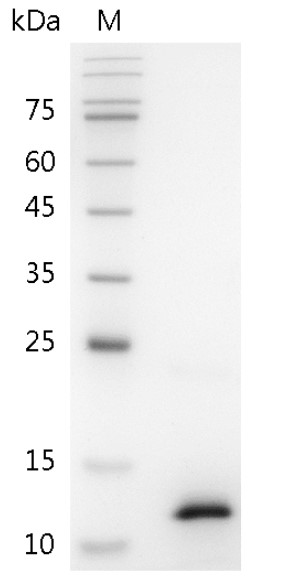| Product name | Mouse CCL3 Protein, His tag (Animal-Free) |
| Sequence | Amino acid sequence derived from Mouse CCL3 (Ala24-ALa92) (P10855) was expressed with 6×His tag at the N-terminus |
| Applications | His tag |
| Applications notes | Mouse |
| Activity | Measured by its ability to chemoattract human PBMCs using a concentration range of 10.0- 100.0 ng/mL. Note: Results may vary from different PBMC donors |
| Protein length | The recombinant Mouse CCL3 consists of 69 amino acids and predicts a molecular mass of 8.69 kDa |
| Preparation method | E. coli |
| Purity | >98% as determined by SDS-PAGE. |
| Alternative | MIP-1a: Macrophage Inflammatory Protein-1α, LD78α |
| Formulation | Lyophilized from PBS, pH 8.0 |
| Features & Benefits | Endotoxin: <0.1 EU per 1 μg of the protein by the LAL method. |
| Molecular weight | 8.69 kDa |
| Usage notes | Always centrifuge tubes before opening. It is recommended to reconstitute the lyophilized recombinant protein to a concentration not less than 100 ug/mL using the buffer we provided, and keep at room temperature for at least 20 min to fully dissolve. Please avoid vortex vigorously |
| Storage instructions | Lyophilized protein product should be stored desiccated below -18°C. Upon reconstitution, the protein should be stored at 4°C between 2-7 days and for future use below -18°C. For long term storage it is recommended to add a carrier protein (5% HSA , 10%FBS or 0.1%BSA). Please prevent freeze-thaw cycles |
| Shipping | Gel pack with blue ice. |
| Precautions | The product listed herein is for research use only and is not intended for use in human or clinical diagnosis. Suggested applications of our products are not recommendations to use our products in violation of any patent or as a license. We cannot be responsible for patent infringements or other violations that may occur with the use of this product. |
| Background | C-C Motif Chemokine Ligand 3 (CCL3)also known as macrophage inflammatory protein 1-alpha (MIP-1-alpha), is expressed in the spleen, lung, and articular cartilage. Upon binding to the receptor, CCR1, CCR4, or CCR5, CCL3 plays a vital role in immune response, such as inflammation, recruitment of immune cells, and production of IL-1β and TNF. In addition, CCL3 also participates in resistance to type 1 virus infection, astrocyte cell migration, regulation of macromolecule metabolic process, and regulation of ERK1 and ERK2 cascade |
| Alternative | MIP-1a: Macrophage Inflammatory Protein-1α, LD78α |
| Accession | P10855 |

You must be logged in to post a review.
Reviews
There are no reviews yet.